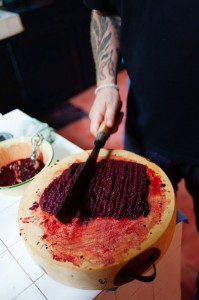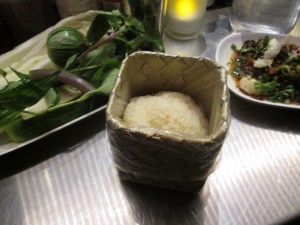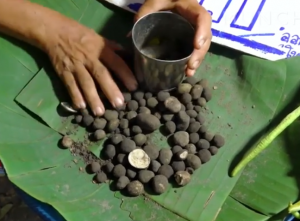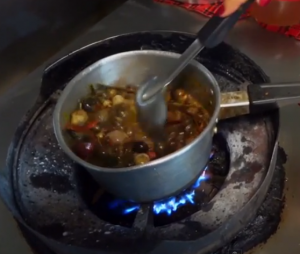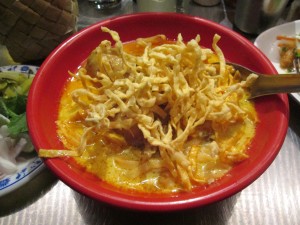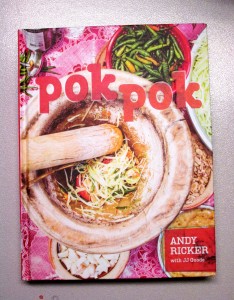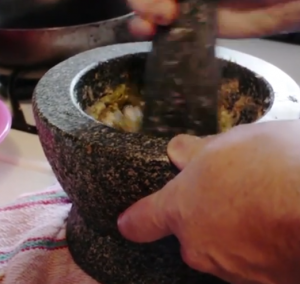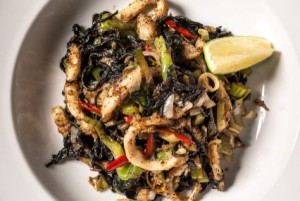(by Corbo Eng)
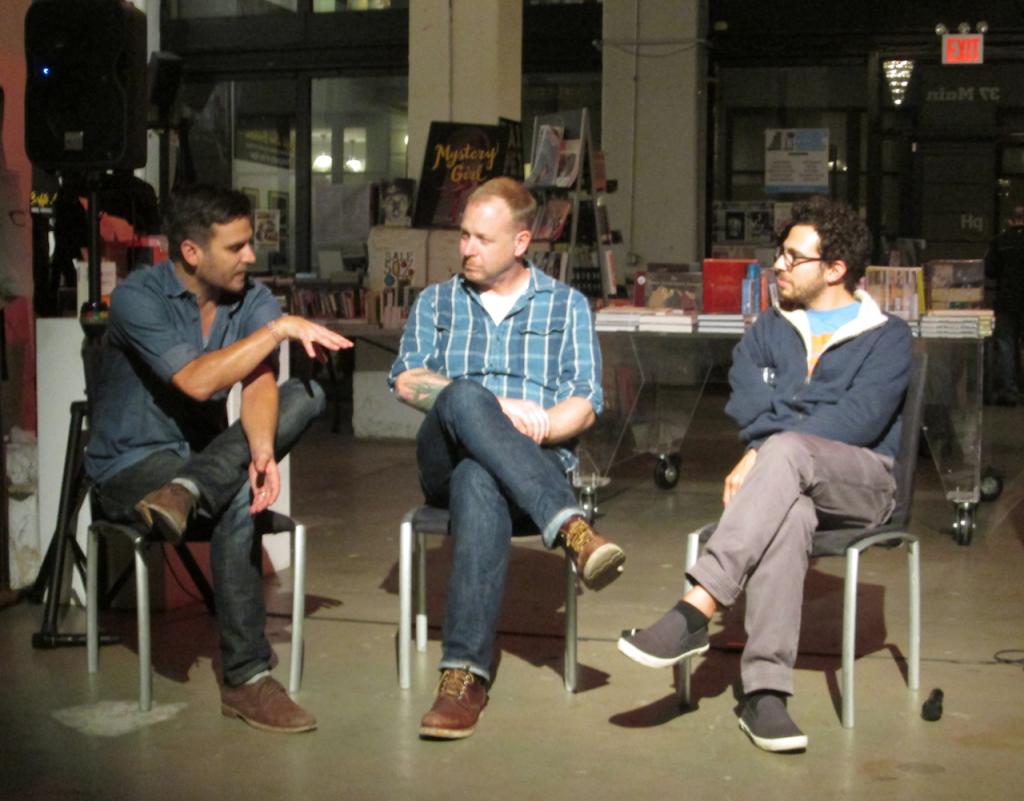
Andy Ricker (center) launching the Pok Pok Cookbook at the Powerhouse Arena in Brooklyn with Andrew Knowlton (left) and JJ Goode (right)
When referring to himself, Andy Ricker—owner of, face of, and emerging icon behind the growing Pok Pok empire—uses terms like “white dude” or “honky” with bite, candor, and deference. They’re words that he’s used on many occasions—having heard them firsthand myself. It’s almost automatic for him by now. They’re signifiers, of course, that qualify his knowledge and achievements and provide a way for Ricker, a clearly humble man, to lower himself a notch or two so that he doesn’t, tacitly, equate his cooking or his authority on the matter of Thai food with, say, a native Thai person’s. But, pushing these terms aside, the issue, inherently, is pretty simple. He’s qualified and entitled to do what he’s doing.
At one point, toward the end of Farang, the newly released documentary about Andy Ricker from VICE, this very issue comes up. Ricker, in a pensive mood, asks, “Should a white dude be making the food of a Southeast Asian culture and making a business out of it? And, you know…it’s a fair enough question to ask.” His interviewer, off-camera, responds just audibly with a hint of incredulity. “Really?” Ricker offers a quick but thoughtful response. “Well…as long as you also ask about the American guy who’s doing Spanish food or the American guy who’s doing Italian food or the American guy who’s doing Indian food…or whatever the fuck it is that honky’s making that isn’t his own. Am I relegated to making hot dogs and fried chicken for the rest of my life because I’m an American?”
Frankly, in today’s mature culinary landscape, where ethnic cuisines of all kinds abound and where yesterday’s expectations and strict paradigms don’t mean much anymore, all kinds of people are cooking and serving Asian food. The closest parallel to Ricker might be Ivan Orkin, a self-proclaimed “Jewish kid from Long Island” who, having spent decades living in and out of Japan after earning a degree in Japanese, has returned to open a duo of acclaimed ramen shops in Manhattan. David Chang, Korean-American and mastermind behind the Momofuku restaurants, serves an eclectic mix of Asian accented food, much that is Japanese-inspired. His staff, both front of house and back are a reflection of today’s restaurant staffs: white, with Hispanic, Asian, and black faces mixed in as well. Chang’s chef de cuisines in New York, at Noodle Bar, Ssäm Bar, and Ko are white. Paul Carmichael at Má Pêche is black. The same diversity is seen, as well, at Talde where Filipino-American chef and Top Chef alum Dale Talde, serves his take on Asian-American food. The same can be said for Danny Bowien at Mission Chinese Food or for Eddie Huang at BaoHaus. All of them have diverse staffs. Of course, no one bats an eyelash at this diversity; it’s America (and, New York, at that…circa 2014). But, those aforementioned men, Ivan Orkin excluded, are all Asian; and, seemingly, that insulates them against charges that they might be venturing into cuisines that aren’t part of their own heritage. When a Korean-American cooks Japanese food, as in the case of David Chang, or Chinese food, as in the case of Danny Bowien, for example…there are minimal if any incongruencies. The public (no pun intended) eats it all up. Andy Ricker, being a “white dude” and not looking the part, has a slightly harder time.
But, just slightly…because, really, to visit Pok Pok and eat the food—be it the ultra popular fish sauce wings, the green papaya salad, or the decidedly more exotic laap meuang (hand minced pork salad)—is to experience, very clearly, the integrity of what Andy Ricker is doing. The Northern Thai food that he serves, like the inanimate objects that they are, don’t extend a hand to congratulate or point a finger to condemn its maker. With one’s tongue tossed around like a rag doll and aroused with a bevy of taste sensations, no one really is preoccupied with who made the food or who owns the restaurant. The diner’s taste buds, like a Star Trek character, have been teleported to Thailand or, more specifically, to some roadside restaurant or stall in Chiang Mai. Once there, “white,” as a stand-in for race or the seeming neutrality of sticky rice, simply blends into the rich colors of the surrounding flavors—flavors that haven’t been compromised and that have been delivered by a man who, despite not being born into the culture, has lived and breathed Northern Thailand for over two decades. In that aforementioned scene from Farang, Ricker points this out in what, ultimately, is an obvious understatement, “I’ve spent twenty-something years studying this food. I feel like it’s okay for me to make the menu that I have.”
Furthermore, when “obsession” and “damned determination” are factors (as Portland Monthly food critic, Karen Brooks asserts in the film), there is the distinct possibility that the “white dude” in question might very well succeed (to the point where he becomes a culinary star and, yes, a James Beard Award winner to boot)…this, despite all signs pointing to the contrary given Ricker’s resume and future prospects at the point in his life when he launched Pok Pok in a shack in Southwest Portland. In the film, Ricker, the eponymous “farang” (meaning “foreigner” or “blonde one” in Thai), certainly, didn’t find success overnight. Ricker, as he, himself, explains it, endured a long journey before Pok Pok catapulted him to national acclaim. In fact, his was a journey, with Thailand as co-protagonist, where nothing was guaranteed. Ricker didn’t have a plan, a goal to shoot for, or a linear career path all laid out in front of him. Andy Ricker would end up a success—but not until he worked as an on-again-off-again cook, bassist in a rock band, and house painter and endured his fair share of dead-ends before finding his way. Yes, he had become a star; but, stars are only born when the force of gravity compresses scattered matter into a whole. Given how scattered he was, that definition, in fact, describes Andy Ricker’s story pretty succinctly.
Andy Ricker, indeed, was once a man of scattered dreams and allegiances. As a young man (post-high school and in his twenties), when young men often drift ceaselessly—either literally or figuratively—to find themselves (even if they consciously know it or not), Ricker, like a vagabond desperate to leave his previous life behind, wandered around the lower Pacific Rim: Australia, New Zealand, Singapore, Malaysia, and Thailand. His life, involving all of this “scattered matter,” slowly started to become “compressed” and “whole.” But, even as he landed in Thailand back then, in his ultimately remarkable journey, he simply had a mindset of having a good time and partying as he saw fit. It didn’t all come together for him immediately.
It was the kind of wandering and living that could, very well, have gone in circles. But, Ricker, luckily, had a seminal moment, which he describes in Farang. That moment was a meal—in the form of a soup, in Chiang Mai, made from a bitter, seasonal mushroom (called “het thawp”) that metaphorically approximated the life-changing effects that others might have gotten from other kinds of mushrooms (of the “recreational” variety). This soup, which had a slightly bitter but herbal flavor profile, was unlike anything Ricker had ever encountered or had associated with Thai food back in the States; and, it, quite literally, expanded his mind and opened doors of seeing (and, more correctly, of tasting) that were once absolutely closed and trapped. From that point on, Ricker’s relationship to Thai food (and with himself) changed forever. That mushroom soup (which is made from that impossibly hard-to-obtain mushroom), unfortunately, isn’t on the menu at Pok Pok (even seasonally); but, there’s an array of offerings that, depending on the diner, may be equally or approximately as mind blowing. Let’s face it. Who really has created a menu quite like Ricker’s—one that is shaped by twenty plus years of travel in Northern Thailand and decades of sleuthing out the secrets and intricate flavor profiles of that region’s food stalls? It’s a menu that kicks open the door to Northern Thai food for an American audience that has never really experienced its wonders and that has been weaned on the familiar preponderances (Thai food influenced by Bangkok and Southern Thai cuisine and generally Americanized for mass consumption).
On a random Sunday night at Pok Pok in Brooklyn, the restaurant is packed as usual—with a line having formed down the block before its five-thirty opening. Pad thai isn’t on anybody’s mind (or plate). And, that’s by design. Instead, guests at different tables have ordered “muu kham waan” (charcoal grilled pork neck), “khao soi kai” (curry noodle soup with bone-in chicken), and “pet pha lo” (duck leg stewed in five-spice broth). Other patrons, having ordered “laap meuang (minced pork salad),” are busy chewing on fresh herbs, such as sawtooth coriander or Thai apple eggplants, as part of their meal or else are pinching out small nodes of sticky rice from its woven bamboo container. Some, encountering intense spice, reach for a sip of pandanus water or for their ginger or tamarind drinking vinegars. This clearly and unequivocally isn’t a scene from “Thai One On Me” (or some other similarly silly sounding Thai restaurant named for a pun that might be found in a local strip mall or the downtown shopping district in Peoria or even on a neighborhood street elsewhere in Brooklyn). This is categorically different. The food is familiar yet tantilizingly unknown—but, ultimately, approachable—like Sichuan food might be for many in relation to the more familiar Cantonese or Chinese-American fare that has dominated the Chinese food scene for so long.
Certainly, the Americanized Thai food that we’ve come to know so well can be a kind of bridge. Despite the huge differences, the template of sweet, salty, sour, and spicy is still very much in play. But, with the food of the North, absent are the familiar proteins, the coconut milk, the accompanying red and green curry sauces, the rice noodles and jasmine scented white rice, and the Thai basil and crushed peanuts that seem to garnish every dish. However, once in—and having explored and tasted Northern Thai food, invariably, for the first time—diners at Pok Pok can’t help but walk away appreciating the boldness of the flavors and the genuineness of the experience that they’ve just had. For every diner who might shake his head and mutter “not for me,” there are many more who must be impressed. Some may be won over enough to seek out Ricker’s cookbook for further exploration on a more thorough and intimate level.
But, they’ll have to be prepared for the same kind of steadfast, obsessive approach that defines Ricker’s restaurant kitchens. Ricker, working with collaborator, JJ Goode, won’t offer any shortcuts. If someone were to stick out his hand and ask for help, Ricker, no doubt, would extend both of his and hand him a mortar and pestle. Ricker believes in it. Making a spice paste or chili dip, for example, he would employ it—despite the tool’s antiquated appearance. He eschews the use of a blender in almost all cases where grinding and pounding are necessary because blenders, a modern convenience, essentially chop ingredients and (with the addition of a lubricating liquid) form purées that lose the textural integrity that characterize pastes and dips that have been pounded out the time-honored way. One would expect as much from Ricker whose mindset, really, mimics that of an ethnographer (someone who is drawn to and studies a foreign culture and the traditions embedded in it). The name “Pok Pok,” a clever bit of onomatopeia that captures the sound of a mortar and pestle, reinforces that time-honored approach to food. And, from that point of view, Ricker is an ethnographer at heart for sure.
He travels to Thailand regularly—with all of the wonder and allure that it holds—going for two to three months at a time to do his “field research,” which, still, after all these years, involves re-calibrating his palate, re-experiencing the flavors that he knows well, or even unexpectedly stumbling upon new foods that he may not have seen before. One can easily picture Ricker, as we see him in Farang, patronizing a ramshackle food stall, eyeing a particular dish, watching the vendor preparing his product—perhaps, in a remote patch of Chiang Mai Province that he, impossibly, hasn’t yet traversed—interviewing locals, taking copious notes, and sniffing out new herbs or strange looking offal at a street side market somewhere. A man, walking such a path, isn’t inclined to change much (if anything) of what he’s found. There’s just too much fascination and respect involved.
The irony is that, really, Thais, themselves—loving their own food yet not discovering it in the context of a life’s journey as Ricker has—can be seemingly more cavalier about what they serve and are much more likely and willing to alter it for the sake of the consumer (or for some other practical or creative reason); and, one doesn’t have to go very far from Pok Pok (in Brooklyn’s Columbia Street Waterfront District) to find evidence of this. In fact, in the adjacent neighborhood of Cobble Hill, about eight or nine blocks east, on bustling Court Street, Joya, a popular Thai restaurant offers up, for instance, a familiar stir fry of pork with cabbage, broccoli, onions, and Thai basil sauce and a familiar green curry with a protein of choice that’s served with bamboo shoots and carrots. Such examples, although not definitive, are representative of how a lot of present Thai food is basically agreeable Chinese-American fare filtered through a Thai lens. The place, sleek and stylish, is consistently packed.
Along the same lines, New York City’s best Thai restaurant for 2013, as named by The Village Voice, is Ngam—a Thai-owned restaurant in the East Village, that boasts “modern Thai food.” Among the most popular items there are the “Thai Burger,” made with hormone-free beef, curry paste, and cilantro lime mayo, and “The Dark Knight,” squid ink egg noodles topped with deep fried calamari and Brussels sprouts. The place is not so much a fusion outpost as it is a place where non-Thai influences and chef-driven riffs are encouraged and embraced. The food is utterly delicious, and it’s emblematic of the kind of Thai food that’s becoming increasingly more trendy and, for what it’s worth, increasingly more removed from its roots. It’s legitimate but the diametric opposite of Pok Pok.
However, Ricker would be the first to dismiss the notion that what he’s doing is serving “authentic” Thai food. He cringes when hearing that word. To him, Thai food is too nuanced, too varied, too lacking in definitive iterations of popular dishes—like any cuisine is—for such a designation to mean much. It’s like trying, here, in this country to anoint some version of barbecue (Kansas City, Texas, or North Carolina) or fried chicken (Buttermilk, Buffalo wings, or KFC) as the authentic version. Which one is the real deal? It’s impossible to say. That’s why Ricker makes it clear that he’s merely trying to duplicate, as faithfully as he can, the food that he’s had in Thailand. In his cookbook, he states, “the recipes in this book are my best approximations of some of my favorite Thai dishes, which have been created, cooked, and perfected by Thai people…I’m a proud copycat.” And, indeed, that’s what we need. What better way is there to establish and represent Northern Thai food in this country than by, first, copying it—and, for someone, like Andy Ricker, who has immersed himself in it so passionately, to cook it and instruct us about it? Besides, for a cat lover—one who tweets pictures of his beloved cats as much, if not more, than images of food porn—it’s a fitting label: copycat. He’ll take it; and, so will we.
Copyright 2013 – 2014 (Corbo Eng). All Rights Reserved.
Photos by Corbo Eng (unless otherwise stated).


